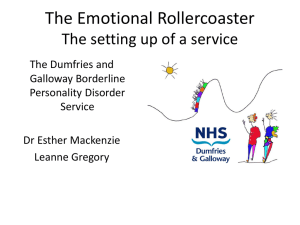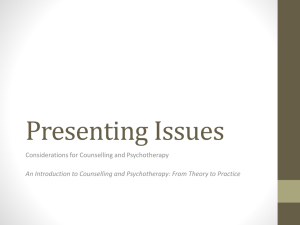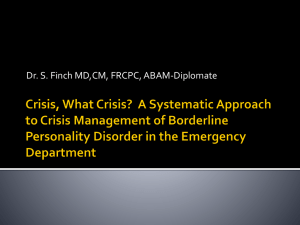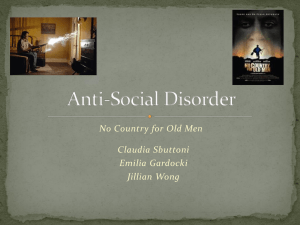How do mental health professionals experience and make sense of
advertisement
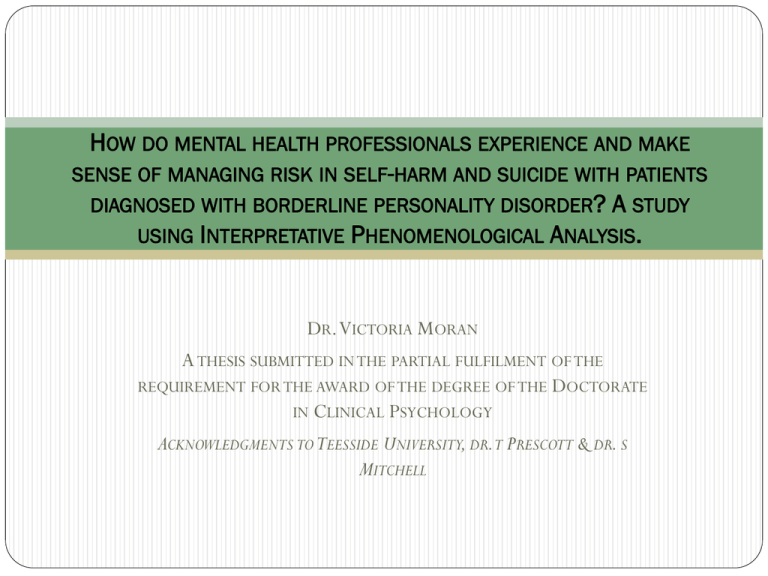
HOW DO MENTAL HEALTH PROFESSIONALS EXPERIENCE AND MAKE SENSE OF MANAGING RISK IN SELF-HARM AND SUICIDE WITH PATIENTS DIAGNOSED WITH BORDERLINE PERSONALITY DISORDER? A STUDY USING INTERPRETATIVE PHENOMENOLOGICAL ANALYSIS. DR.VICTORIA MORAN A THESIS SUBMITTED IN THE PARTIAL FULFILMENT OF THE REQUIREMENT FOR THE AWARD OF THE DEGREE OF THE DOCTORATE IN CLINICAL PSYCHOLOGY ACKNOWLEDGMENTS TO TEESSIDE UNIVERSITY, DR.T PRESCOTT & DR. S MITCHELL Overview Summary of literature Research design Findings Summary of super-ordinate & sub-ordinate themes Discussion Limitations Implementation Conclusions Literature Summary ‘BPD’ “A pervasive pattern of instability of interpersonal relationships, self-image, and affects, and marked impulsivity beginning by early adulthood and present in a variety of contexts as indicated by five (or more) traits”. Diagnostic process for PD can be problematic for some of the following reasons: Overlap and co-morbidity with other mental health diagnoses (NICE, 2009; Zanarini, Frankenburg, Hennen, Reich & Silk, 2004; Zimmerman & Mattia, 1999) Breadth of individual presentations that diagnostic criteria can generate (Cooper, Balsis & Zimmerman, 2010) No single cause attributed to development (Kupfer, First & Regier, 2002; Pilgrim, 2001) Lack of biological evidence (Paris, 2008) Debate transcends from a theoretical research framework into the working clinical world. The key features which define personality disorder are necessary and allow clinicians to assess and provide interventions. Additionally, diagnosis enables individuals who have intense interpersonal difficulties to be identified and receive appropriate therapeutic input (Paris, 2008). Attitudes towards BPD Aversion to working with this group Individuals who receive a diagnosis of PD can feel overcome with powerful emotions which may influence the emotional experience of clinicians (Aviram et al., 2006). The self-destructive behaviours that individuals with BPD demonstrate can evoke feelings of incompetence within teams (Cleary et al., 2002). Subsequently, negative attitudes may reflect an underlying fear staff have when working with individuals that are both impulsive and chronically risky. Murphy and McVey (2003) reviewed the challenges of nurses working with personality disordered patients. Noted that lack of personal qualities and appropriate skills intensified the difficulties nurses experienced in comparison to other psychiatric diagnosis. Risk & BPD Managing suicidal patients is one of the most stressful tasks undertaken by clinicians (Jobes, 1995). Literature is beginning to emerge that considers healthcare professionals experiences of managing risk, self-harm and suicide (Lindgren, Oster, Aström, Hällgren & Graneheim, 2011; McAllister, Creedy, Moyle & Farrugia, 2002; Thompson, Powis & Carradice, 2008; Wilstrand, Lindgren, Gilje & Olofsson, 2007). No research specifically with explicit links on professionals experience of managing risk of self-harm and suicide in BPD. Suicide risk in BPD individuals across their lifetime is approximately 8- 10% (APA, 2001). Within a hospital based sample, 45.9% of patients with personality disorder have deliberately self-harmed ([DSH], Haws, Hawton, Houston & Townsend, 2001). Risk & BPD Fowler (2012) comments that when assessing suicide and self-harm, focusing on meaning and understanding collaboratively with patients can contribute towards the avoidance of aversive outcomes. However, building such a collaborative relationship can be problematic with individuals diagnosed with BPD (Nehls, 2000), particularly if they continuously engage in selfharming or suicidal behaviours (Commons Treloar & Lewis, 2008). So how do mental health professionals experience such a dynamic and challenging aspect of their work with BPD? Clinical Context Two main policy drivers exist that have substantially shaped the experience that clinical staff can have with patients with BPD. Personality Disorder: No longer a diagnosis of exclusion (National Institute of Mental Health [NIMHE], 2003). National Suicide Prevention Strategy for England (Department of Health [DoH], 2003) & updated Preventing suicide in England: A cross-government outcomes strategy (DoH, 2012) Drivers create a context of inclusion and reduction. So what is this like for clinicians when trying to manage risk with a complex patient group? Rationale Literature captures feelings of difficulty and incompetence in staff who work with BPD (Cleary, Siegfried & Waters, 2002; James & Cowman, 2007; Lewis & Appleby, 1988). There is no published research that clearly highlights how mental health professionals make sense or experience aspects of risk management explicitly with BPD. This gap is particularly pertinent with BPD because a primary feature of the disorder is self-harm and suicidal behaviours. National drivers highlight a tension between inclusion and suicide reduction. Clinicians are faced with systemic and organisational pressure in addition to working with a complex client group. Current Research The research question posed is: How do mental health professionals experience and make sense of managing risk in self-harm and suicide with patients diagnosed with borderline personality disorder? A qualitative approach was adopted to answer this question. Aim was to develop a coherent narrative of an explorative nature into what it is like to manage risk with individuals diagnosed with BPD. The researcher is seeking to explore participants’ lived experience of managing suicide and self-harm in patients diagnosed with BPD and therefore the participants’ working environment and context is important. Current Research Design The use of Interpretative Phenomenological Analysis (IPA) allows for some psychological insight into the experience of managing risk with patients with a diagnosis of BPD. Qualitative approaches are suitable when considering individuals’ experiences in depth, particularly when the research is undertaken in novel areas (Barker, Pistring & Elliot, 2002) Both collective and idiographic experiences of the mental healthcare professionals considered. Participants Participant Gender Age P1 Female 50 P2 Female 46 P3 Male 26 P4 Male 39 P5 Female 37 P6 Male 49 P7 Female 51 Backgrounds and Professions included: Occupational Therapy, Nursing, Psychology, Social Work Research Design Interpretative Phenomenological Analysis (IPA) 1. Researchers initial encounter with the text 2. Identification of themes 3. Clustering of themes 4. Production of summary 5. Integration of cases 6. Write up (Willig, 2008, pp. 60 - 63) Findings Superordinate Themes Sub-ordinate Themes Clinicians’ experiences with self Clinicians’ experiences with the patient Power, Control, and Uncertainty World of Conflicts, Paradox, and Unpredictability Recognising limitations to role Positive regard and bond with the patient Attempts to gain control through a conscious process ‘You’ve got to be prepared to say, yeah okay, I know what my limits are, lets go’ P5: 570 - 571 ‘I do like the patients, I do like my patients, I like hanging out with them’ P5: 150 - 152 ‘Formulation and a really good understanding of where they’ve come from. So all that background history’. P3: 161 – 162 Multifaceted, incongruent emotional experience Rejection of assumptions, stigma, and labels associated to patient Patient and risk as powerful and uncertain ‘I don’t know what a normal personality is so I don’t know what a disordered personality is’ P6: 8 - 9 ‘Everything’s got to stop now because I do have to go out and react to this because I can’t not react to this’ P2: 355 - 356 Personal self as part of the professional self ‘It’s a bit of a maternally, parentally thing where you can be a bit tough but this kind of compassion, erm, professional tolerance’ P2: 124 – 126 Coping utilised with the patient in the working role Searching for meaning in risky behaviour ‘You’re rubbish and you’re a social worker so you don’t know anything. Just the normal things you get told’. P1: 363 – 365. ‘It is a way of expressing emotions erm, when you cannot think of other ways to do it I suppose’. P7: 70 – 71 ‘Ahhhh, well sometimes anxious, sometimes I have a bit of doubt, sometimes feel sad, sometimes feel angry’. P6: 365 – 366. Clinicians’ experience within a system as conflicting and ambiguous ‘There is no policy that says at this point is when you do this, right, so it is all kind of, down to judgement’ P1: 397 – 398 Key Findings The super-ordinate themes demonstrated a level of shared understanding and commonality amongst participants in how they experience risk of self-harm and suicide in BPD. However, the detail within the sub-ordinate themes highlighted the differences and individual experiences amongst participants Multi-faceted and complex experience: On one hand, participants feel a bond and relationship with the patient that can be shaped by and influence their own experience as a mental health professional. On the other hand, participants recognise the power that risks hold with regard to the wider systemic influences. Participants therefore experience incongruence in their work and can often utilise personal coping, defences and conscious cognitive processes to manage the work they carry out with suicide and self-harm in BPD. Key Findings Participants alluded to a divide within their work managing risk of self-harm and suicide. This was shared between their work with the patient and their work within the system. However negative or emotionally difficult the work with the patient was, participants were able to find a positive regard and view of the patient. Participants quite strongly and actively rejected the labels and stigma associated with individuals diagnosed with BPD. However, in some experiences, there was the propensity for boundaries to be weakened in the relationship with the patient when risk was present. This left the participants caught with their professional roles and responsibilities spilling into their personal worlds in the form of anxiety, worry and fear. Super-ordinate Theme 4 - World of Conflicts, Paradox and Unpredictability Sub-ordinate themes: Multifaceted, incongruent emotional experience ‘Ahhhh, well sometimes anxious, sometimes I have a bit of doubt, sometimes feel sad, sometimes feel angry’. P6: 365 – 366. Clinicians’ experience within a system as conflicting and ambiguous ‘There is no policy that says at this point is when you do this, right, so it is all kind of, down to judgement’ P1: 397 – 398 Sub-ordinate Theme 1 - Multifaceted, incongruent emotional experience It emerged from all participants that the working environment was often emotionally charged. All participants talked about the emotional impact of managing risk of self-harm and suicide with patients diagnosed with BPD. The power of emotions experiences extended into participants home environment. Paradoxes featured in the experiences of participants such as a reward – punishment paradigm. Multifaceted, incongruent emotional experience The relentlessness of erm, if someone is in constant crisis it can feel like you're not making much progress, but then it can be very rewarding if you do, erm, discharge and if they get what they want, they get their life worth living type thing (P3: 387-390). Ahhhh, well sometimes anxious, sometimes I have a bit of doubt, sometimes feel sad, sometimes feel angry (P6: 365-366). Erm, so I certainly had a lot of sympathy for him but, erm, erm, and you know I could see that he was, he was trying, he was trying to improve the situation. Erm, but then he would do things which would quite annoying me as well actually (P4: 125-128). Sub-ordinate Theme 2 - Clinicians experience within a system as conflicting and ambiguous All participants talked about struggles relating to the management of self-harm and suicide with individuals diagnosed with BPD. Generally, this was associated with ambiguity and conflict in the system in which they work. Attention drawn by some participants to a lack of guidance when making decisions about self-harm and suicide. A sense of isolation and blame stemmed from systems in which participants worked. Clinicians experience within a system as conflicting and ambiguous I mean there is no policy that says at this point is when you do this, right, so it is all, kind of, down to judgement. At the same time, you can't kind of be rushing in with the, you know, erm, you can't be rushing in with every mental health act assessment every time somebody cuts themselves. So I think making that judgement is quite difficult. And [sigh], I think if you err on the side of caution it takes the responsibility away from the patient and I don't think that that is always helpful (P1: 396-404). Powers that be would have it, that there is plenty of support out there, but I think when you’re sat in somebody’s home making individual judgments erm, there isn’t…it doesn’t always feel that supported (P2: 289-292). In that people are saying, you know, we need to take lots of risk, we need to, you know, allow people a bit more freedom.When there is an SUI it’s ohh who’s going to get it, take the rap for this. So I think again people, erm, what they say just isn’t congruent with the organisation policies (P6: 471-475). Discussion At present theoretical literature that is specific to suicide and BPD is sparse (Chance, Bakeman, Kaslow, Farber & Burge-Callaway, 2000). A psycho-dynamic theoretical framework was used to discuss and make sense of the experiences captured across the super-ordinate themes. Super-ordinate theme 4: World of Conflicts, Paradox and Unpredictability From the emergent themes it is recognised that there is incongruence between clinical work and managerial drivers with risk in BPD. There was a level of awareness to some of the conflict experienced in the working world. Unconscious Dynamics The super-ordinate theme of power, control, and uncertainty also demonstrated elements of less conscious influence. Malan’s (1995) ‘triangle of conflict’ provides a theoretical framework to understand the dynamics that can unconsciously emerge in the professionals’ world. Defence: Splitting Projection Denial Anxiety: Conflict/Turmoil, Incongruent & multifaceted emotions Hidden Feeling: Questioning of ‘caring’ integrity Anger Dislike of patient / Want them to be harmed Triangle of conflict… Healthcare professionals may experience strong, negative and intense yet hidden feelings towards the patient. Such hidden feelings remain elusive because bringing them into consciousness is an unbearable, intolerable experience for professionals who are employed to ‘care’ for others. These feelings can create a level of anxiety which needs to be managed and defended against. To defend against such tension professionals can evade the thoughts becoming conscious by disregarding the internal conflict or tension. The participants were conscious of power, control and uncertainty associated with risk. By discussing the impact of risk, healthcare professionals are displacing the internal conflict that stems from the interaction with the patient and are therefore maintaining their personal and professional integrity. ‘Splitting’ Less conscious aspects of ‘splitting’ emerged within this theme. In psycho-dynamic terms the defensive practice of ‘splitting’ allows individuals to keep apart two conflicting, uncertain or opposing worlds (Klein, 1952). The defence of splitting has historically and commonly been associated with individuals diagnosed with BPD (Kernberg, 1967; Lichtenberg & Slap, 1973; Zanarini, Weingeroff & Frankenburg, 2009). Professionals may mirror aspects of the patient’s experiences through counter-transference interactions. Therefore, participants may naturally split their world of work with the patient and system into ‘good’ and ‘bad’ facets (Klein, 1952). ‘Splitting’ Working with the patient and within the system is difficult for the participant to integrate resulting in a projection of negativity towards the system and a positive regard for the patient. When integration was attempted participants talked about bringing the two opposing areas of inclusion and risk reduction. Participants wanted to take short term risks therapeutically in order to benefit the patient in the longer term. This is an area supported theoretically with BPD (Krawitz, Jackson, Allen, Connell, Argyle, Benesemann, Mileshikin, 2004; Paris, 2005) and self-harm (NICE, 2004 & 2012). If there is a drive to reduce risk in a service and give inclusivity to those with a PD diagnosis, it appears that something has to give in order for clinicians to be able to achieve this. Limitations Qualitative research specifically in BPD and suicide and self- harm management is still sparse and so current study only adds to a small body of literature. Purposive sampling, aimed at three groups within Adult MH. However, no individuals participated from Crisis team. Only one Mental Health Trust recruited from. Implications Contribution to under researcher area. Evidence that participants are striving to care whilst endeavouring to maintain a professional boundary. Promotion of supervision weighted in evidence. Supervision should focus on the emotional impact of working with self-harm. Provides space to share the difficult multi-faceted experiences of risk in BPD. Supervision can also focus on counter-transference and relational dynamics. Promoting of risk-tolerant approach in wider systems. Support and education for managers who are not clinically trained to work with PD may be beneficial in the development of shared understanding of patients with BPD. Conclusions The emergent themes highlighted that the experience of managing self-harm and suicide with patients diagnosed with BPD is multi-faceted and complex. A divide emerged were participants felt a bond and relationship with the patient that can be shaped by and influence their own experience as a mental health professional. However, participants also recognised the power that risks hold in regards to the wider systemic influences. Participants experienced incongruence in their work and utilised personal defences and conscious cognitive processes to manage the work they carry out with suicide and self-harm in BPD. References American Psychiatric Association (2001). Practice guideline for the treatment of patients with borderline personality disorder. American Journal of Psychiatry, 158, 1–52. Aviram, R. B., Brodsky, B. S., & Stanley, B. (2006). Borderline personality disorder, stigma and treatment implications. Harvard Review of Psychiatry, 14, 249-256. Barker, C., Pistrang, N. & Elliott, R. (2002). Research methods in clinical psychology: An introduction for students and practitioners (2nd ed.). Chichester: Wiley. Bernstein, D. P., Iscan, C., Maser, J., (2007). Opinions of personality disorder experts regarding the DSM-IV personality disorder classification system. Journal of Personality Disorders, 21(5), 536551. Cleary, M., Siegfried, N., & Walter, G. (2002). Experience, knowledge and attitudes of mental health staff regarding clients with a borderline personality disorder. International Journal of Mental Health Nursing,11(3), 186–191. Commons Treloar, A. J., & Lewis, A. J. (2008). Professional attitudes towards deliberate self-harm I n patients with borderline personality disorder. Australian and New Zealand Journal of Psychiatry, 42, 578-584. Cooper, L. D., Balsis, S., & Zimmerman, M. (2010). Challenges associated with a polythetic diagnostic system: Criteria combinations in the personality disorders. Journal of Abnormal Psychology, 119(4), 886-895. Chance, S. E., Bakeman, R., Kaslow, N. J., Farber, E., & Burge-Callaway, K. (2000). Core conflictual relationship themes in patients diagnosed with borderline personality disorder who attempted, or did not attempt suicide. Psychotherapy Research, 10(3), 337-355. References Department of Health (2003) . National Suicide Prevention Strategy for England. London: Department of Health. Retrieved from http://www.nmhdu.org.uk/silo/files/national-suicide-prevention-strategy- for-england.pdf Department of Health (2012). Preventing suicide in England: A cross-government outcomes strategy. London: HM Government / Department of Health. Retrieved from https://www.gov.uk/government/uploads/system/uploads/attachment_dat a/file/156153/Preventing-Suicide-in-England-A-cross-government-outcomes-strategy-to-savelives.pdf.pdf Evans, M. (2007). Being driven mad: Towards understanding borderline and other disturbed states of mind through the use of the countertransference. Psychoanalytic Psychotherapy, 21(3), 216-232. Fowler, J. C. (2012). Suicide risk assessment in the clinical practice: Pragmatic guidelines for imperfect assessments. Psychotherapy, 49(1), 81–90. Haws, C., Hawton, K., Houston, K., & Townsend, E. (2001). Psychiatric and personality disorders in deliberate selfharm patients. British Journal of Psychiatry, 178, 48–54. James, P. D., & Cowman, S. (2007). Psychiatric nurses’ knowledge, experience and attitudes towards clients with borderline personality disorder. Journal of Psychiatric and Mental Health Nursing, 14, 670-678. Jobes, D. A. (1995). The challenge and the promise of clinical suicdology. Suicide and life-threatening behaviours, 25, 437– 449. Kernberg, O. (1967). Borderline personality organization. Journal of the American Psychoanalytic Association. 15, 641–684. Klein, M. (1952/1975). Some theoretical conclusions regarding the emotional life of the infant. In M. Klein (Eds.), Envy and Gratitude and OtherWorks, (pp. 61 – 93). London: Hogarth. Krawitz, R., Jackson, W., Allen, R., Connell, A., Argyle, N., Bensemann, C., & Milshkin, C. (2004). Professionally indicated short-term risk-taking in the treatment of borderline personality disorder. Australasian Psychiatry, 12(1), 11-17. References Kupfer, D. J., First, M. B., Regier, D. A. (2002). A research agenda for DSM-V. Washington, DC: American Psychiatric Press. Lewis, G., & Appleby, L. (1988). Personality disorder: the patient’s psychiatrists dislike. British Journal of Psychiatry,153, 44–49. National Institute for Health and Clinical Excellence (2012). Self-harm longer term management (Clinical Guideline 133). Retrieved from http://www.nice.org.uk/nicemedia/live/13619/57205/57205.pdf Nehls, N. (2000). Being a case manager for persons with borderline personality disorder: Perspectives of community mental health center clinicians. Archives of Psychiatric Nursing, 14(1), 12-18. New, A. S., Triebwasser, J., Charney, D. S. (2008). The case for shifting borderline personality disorder to Axis I. Biological Psychiatry, 64, 653–59. Paris, J. (2005). Borderline personality disorder. Canadian Medical Association, 172(12), 1579-1583. Paris, J. (2008). Treatment of Borderline Personality Disorder: A Guide to Evidence-based practice. Guildford Press: New York. Pilgrim, D. (2001). Disordered personalities and disordered concepts. Journal of Mental Health, 10, 253265. Raven, C. (2009). Borderline personality disorder; still a diagnosis of exclusion? Mental Health Today. June, 27-31. Thompson, A. R., Powis, J., & Carradice, A. (2008). Community psychiatric nurses’ experience of working with people who engage in deliberate self-harm. International Journal of Mental Health Nursing, 17, 153–161. Willig, C. (2008). Introducing Qualitative Research in Psychology (2nd ed.). Maidenhead: McGraw Hill/Open University Press. References Wilstrand, C., Lindgren, B. M., Gilje, F., & Olofsson, B. (2007). Being burdened and balancing boundaries: a qualitative study of nurses’ experiences caring for patients who selfharm. Journal of Psychiatric and Mental Health Nursing, 14, 72–78. Zanarini, M. C., Frankenburg, F. R., Hennen, J., Reich, D. B., & Silk, K. R. (2004). Axis I comorbidity in patients with borderline personality disorder: a 6-year follow-up and prediction of time to remission. American Journal of Psychiatry, 161(11), 2108–2114. Zanarini, M. C., Weingeroff, J. L., & Frankenburg, F. R. (2009). Defence mechanisms associated with borderline personality disorder. Journal of Personality Disorders, 23(2), 113-121. Zimmerman, M. & Mattia J. I. (1999). Axis I diagnostic comorbidity and borderline personality disorder. Comprehensive Psychiatry, 40, 245–252. Thank you victoria.moran@nhs.net
